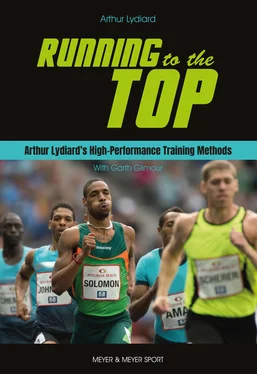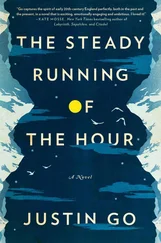What happens when the runner sprints or shifts his work-rate into the anaerobic phase is that oxygen is no longer absorbed fast enough for the fat and glycogen breakdown. The body will then cheat and break down glycogen without oxygen.
The difference is that aerobic metabolism produces innocent wastes, water and carbon dioxide; anaerobic metabolism produces lactic acid, which, as it accumulates, progressively prevents the muscles from contracting.
The anaerobic system will function temporarily even during a long run at a basically aerobic work-rate – when you tackle a tough hill or kick in a burst of speed, for instance – and certainly will when aerobic metabolism can no longer supply the energy you need to sustain your pace. In fact, even when you begin a run slowly, you are likely to be running anaerobically until your aerobic mechanism reacts and takes charge. This should be borne in mind to guard against going out too fast at the start of a race or training session or failing to warm up adequately to prepare the aerobic mechanism.
No matter how hard or deeply you breathe, the oxygen your muscles can use is limited to your maximal aerobic capacity, or maximum oxygen consumption, known as VO2. It is calculated by the amount of oxygen you can consume each minute divided by your fat- free weight. All other things being equal, therefore, the large person can use more oxygen than the small one.
VO2, naturally, varies widely. A normally active mid-twenties male can use between 44 and 47 ml of oxygen for each kilogram of fat-free weight each minute. Top endurance runners can lift their capacity to more than 70 ml/kg/min. Women score, on average, lower than men because, pound for pound, their muscle mass is less. But the gap between male and female VO2 capabilities is reducing rapidly as more and more women work to training schedules as tough as men’s.
How widely the VO2 can vary can be seen in any marathon race. The top runners will be cruising aerobically on their high VO2 at around five-minute miles; at the back of the field are runners who couldn’t cover one mile at that pace because they would be completely anaerobic. Their lower aerobic capacity means they can run their consecutive miles only at a much slower pace.
In aerobic exercise, one molecule of glycogen forms 38 molecules of ATP. Anaerobic exercise yields only two. And Morehouse and Miller, in Physiology of Exercise , consider that severe anaerobic work is only 40 per cent as efficient as aerobic work.
The elite runner covers distances at high speeds aerobically because his or her muscles are able to break down and release fat from the fat cells and oxidise the fat as fuel. During sub-maximal exercise, fat is the main fuel. When your muscles are metabolising mainly fat, the oxygen demand is greater than when burning glycogen, which means you either have to take in more air or slow down. Fat, therefore, is not the preferred fuel for fast running.
In shorter races, say, under 10 km, runners burn glycogen almost exclusively. When the marathon runner burns fat efficiently, the glycogen is conserved and is available for that fast finish over the last ten miles that wipes out the opposition. Once you have established the base of muscular endurance, maintaining muscular strength and tone is attainable by developing the muscle fibre through the application of resistance – by lifting weights or running up stairs or hills.
Again, since the muscles contain both red and white fibres (otherwise known as slow-twitch and fast-twitch), you have to define exercises which work on both. No amount of exercise will change the balance of red and white fibres you were born with but you can improve their efficiency. The slow-twitch fibres are the best for aerobic metabolism, the powerful fast-twitch fibres for anaerobic metabolism.
The diaphragm and extensor muscles that maintain posture are red or slow-twitch muscles; muscles in which the white fibres predominate, including most of the flexor muscles, are specialised for speed and tire more easily.
Essentially, we have to develop oxygen uptake to make our body machinery function better. The net results will be, hopefully, a delaying of the aging process and, certainly, an improvement in both muscular and mental endurance. We will find that, when we don’t tire physically, we don’t tire mentally either.
I have proved this in training high school boys and girls. Not only did they improve as athletes, they also became better students. They were able to study longer and more effectively without suffering from mental fatigue. Quite a few who became national athletic champions were also duxes or top academic pupils at their schools.
In Finland, one newspaper took me to task, declaring that the training programme I was laying out for high school boys was too severe and would affect their studies. Three of those boys won Finnish high school championship events and one of them became dux of his school.
There is no necessary distinction between the sporting jock and the academic swot; the one attribute goes hand in glove with the other. They can be the same person. The high oxygen uptake levels of properly trained athletes feed a better oxygen supply to all parts of their bodies, including their brains.
CHAPTER 3
THE BASICS OF YOUTH
The great Swedish coach Gosta Holmer, head Olympic coach in 1948, said that if you can get an athlete in his teens to train but not race until he is mature, you will have laid the foundation for an Olympic champion. It’s an ideal I’ve always agreed with, the reason why I’ve always insisted on taking the long view with athletes who want to become champions in a hurry. There are no safe shortcuts.
When I was in Kenya, I was reminded once more of the lesson the African athletes have given us since they began dominating middle and distance running around the world. Part of their way of life has been doing exactly what Holmer preached.
In Kenya, as in other African nations, many youth run to and from school every day of the school year. No cars, no buses, just their own legs. One youth called Biwott, for instance, ran ten miles to school and ten miles home again five days a week – one hundred miles a week. He became an Olympic champion at the 1968 Games in Mexico, which illustrates how long the message of this great potential for success has been around. These kids run because it’s the only way for them to go. They run with no pressure on them, no racing except in fun, and all the time they are laying a wonderful foundation of high oxygen uptake and endurance so that, when they finally turn out in a race somewhere, many of them produce fantastic times. We saw this in the 1988 world cross-country championships when the junior Kenyans proved far superior to anyone else. Now the Moroccans, Tunisians, Algerians and others who are moving into the international scene are also running fast times because they, too, have done so much aerobic running as young kids that they have a huge natural base on which to build speed and proper technique.
In the US, when young kids show any form at high school, the tendency is to put them on the track and pile the anaerobic work into them. Consequently, they don’t develop.
We know that young people, before they reach puberty and go through that fast growth spurt, have the ability to use oxygen more efficiently for their body weight than adults. They also have highly sensitive nervous systems so they are protected by nature to be able to continue activity for a long time at the aerobic level. But they cannot stand heavy doses of anaerobic training and pressure from coaching regimens to race a lot. This occurs in many of the affluent countries, usually because sporting success is as good for an educational institute as academic success, and success means better funding. These youngsters, therefore, don’t develop their aerobic capacity sufficiently so when, as adults – if they’re still interested in running – they come up against the Africans, and their relatively low oxygen uptake level is no match for their opponents’ high level. When the pressure goes on in a race, they lose knee lift, they experience neuromuscular breakdown, they can’t sprint at the end – and the Africans can.
Читать дальше












